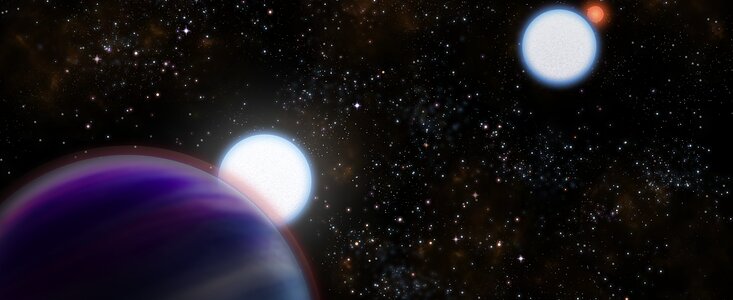Exoplanets Can’t Hide Their Secrets from Innovative New Instrument
29 August 2019
In an unprecedented feat, an American research team discovered hidden secrets of an elusive exoplanet using a powerful new instrument at the 8-meter Gemini North telescope on Maunakea in Hawai‘i. The findings not only classify a Jupiter-sized exoplanet in a close binary star system, but also conclusively demonstrate, for the first time, which star the planet orbits.
The breakthrough occurred when Steve B. Howell of the NASA Ames Research Center and his team used a high-resolution imaging instrument of their design — named ‘Alopeke (a contemporary Hawaiian word for Fox). The team observed exoplanet Kepler-13b as it passed in front of (transited) one of the stars in the Kepler-13AB binary star system some 2,000 light years distant. Prior to this attempt, the true nature of the exoplanet was a mystery.
“There was confusion over Kepler-13b: was it a low-mass star or a hot Jupiter-like world? So we devised an experiment using the sly instrument ‘Alopeke,” Howell said. The research was recently published in the Astronomical Journal. “We monitored both stars, Kepler A and Kepler B, simultaneously while looking for any changes in brightness during the planet’s transit,” Howell explained. “To our pleasure, we not only solved the mystery, but also opened a window into a new era of exoplanet research.”
More information
NSF’s NOIRLab (National Optical-Infrared Astronomy Research Laboratory), the US center for ground-based optical-infrared astronomy, operates the international Gemini Observatory (a facility of NSF, NRC–Canada, ANID–Chile, MCTIC–Brazil, MINCyT–Argentina, and KASI–Republic of Korea), Kitt Peak National Observatory (KPNO), Cerro Tololo Inter-American Observatory (CTIO), the Community Science and Data Center (CSDC), and Vera C. Rubin Observatory (in cooperation with DOE’s SLAC National Accelerator Laboratory). It is managed by the Association of Universities for Research in Astronomy (AURA) under a cooperative agreement with NSF and is headquartered in Tucson, Arizona. The astronomical community is honored to have the opportunity to conduct astronomical research on Iolkam Du’ag (Kitt Peak) in Arizona, on Maunakea in Hawaiʻi, and on Cerro Tololo and Cerro Pachón in Chile. We recognize and acknowledge the very significant cultural role and reverence that these sites have to the Tohono O'odham Nation, to the Native Hawaiian community, and to the local communities in Chile, respectively.
About the Release
| Release No.: | noirlab1906 |
| Facility: | Gemini North |
| Instruments: | ‘Alopeke |
| Science data: | 2019AJ....158..113H |


